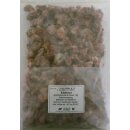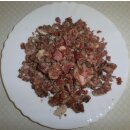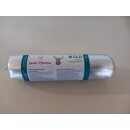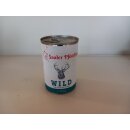Hypoallergenic Food
Hypoallergenic Food for Dogs and Cats: A Comprehensive Guide
What is hypoallergenic food?
Hypoallergenic food is specially formulated to minimize food allergies and intolerances in pets. It usually contains limited ingredients that are carefully selected to avoid allergic reactions. Hypoallergenic food typically does not contain common allergens like certain proteins or grains.
Why choose hypoallergenic food?
Choosing hypoallergenic food can bring many benefits to your pet. It helps reduce or avoid allergic reactions such as skin problems, digestive disorders, and itching. This can significantly improve the quality of life for your dog or cat.
Common allergens in pet food
Food allergies are often triggered by specific proteins or grains. The most common allergens include beef, dairy products, wheat, chicken, lamb, soy, eggs, and fish. Hypoallergenic food avoids these ingredients and instead uses alternative protein and carbohydrate sources.
How to recognize a food allergy?
A food allergy can manifest through various symptoms. These include itching, rashes, hair loss, digestive issues such as diarrhea or vomiting, and chronic ear infections. A visit to the veterinarian can help diagnose the exact cause.
Benefits of hypoallergenic food
Hypoallergenic food offers many benefits, including reducing allergic reactions and supporting healthy skin and fur. It can also strengthen the immune system and promote overall health in your pet.
Composition of hypoallergenic food
Hypoallergenic food contains special ingredients considered less allergenic. These include novel proteins like duck, venison, kangaroo, or rabbit, and alternative carbohydrate sources like sweet potatoes, peas, or quinoa. These ingredients are carefully selected and tested to ensure they are suitable for sensitive pets.
Difference between hypoallergenic and sensitive food
Hypoallergenic food and sensitive food are often confused but serve different purposes. Sensitive food is designed to be easily digestible and minimize digestive problems, whereas hypoallergenic food is specifically developed to avoid allergic reactions.
How is hypoallergenic food made?
The production of hypoallergenic food involves strict controls to avoid cross-contamination with allergens. The ingredients are often hydrolyzed, meaning the proteins are broken down into smaller molecules that are less likely to trigger an allergic reaction.
When is hypoallergenic food advisable?
Hypoallergenic food is advisable if your pet shows signs of a food allergy or has a diagnosed allergy. It can also be used preventively if allergies are known to be common in the pet's family.
Hypoallergenic food for puppies and kittens
Puppies and kittens have special nutritional needs, and hypoallergenic food for young animals is tailored to meet these needs. It ensures they get all the necessary nutrients without the risk of allergies.
Hypoallergenic dry food vs. wet food
Both options have their pros and cons. Dry food is convenient and has a longer shelf life, while wet food is often more palatable and hydrating. The choice depends on your pet's preferences and needs.
Transition to hypoallergenic food
The transition to hypoallergenic food should be gradual to avoid digestive problems. Start by mixing small amounts of the new food with the old and increase the amount over a period of 7-10 days.
Hypoallergenic food for special diets
If your pet has special dietary requirements, consult your veterinarian about integrating hypoallergenic food. This is particularly important for conditions like diabetes, kidney problems, or obesity.
Allergy tests and diagnosis
To confirm that your pet has a food allergy, various tests can be conducted, including elimination diets and blood tests. These help identify the specific allergens.
Nutritional tips for allergic pets
In addition to choosing the right food, there are other measures that can help manage allergies. These include regular veterinary check-ups, avoiding treats with unknown ingredients, and monitoring your pet's environment.
Feeding routine for allergies
A consistent feeding routine is crucial to minimizing allergic reactions. Stick to regular feeding times and avoid sudden changes in diet.
Common mistakes in feeding
Avoid switching between different food types too quickly or giving your pet table scraps. Both can exacerbate allergies or cause new problems.
Costs and availability of hypoallergenic food
Hypoallergenic food can be more expensive than regular food, but the investment is often worthwhile as it supports your pet's health and well-being. It is available in our shop, where you can find a wide selection of hypoallergenic food varieties.
Quality criteria for hypoallergenic food
Look for hypoallergenic food with clear and natural ingredients. Avoid products with artificial additives, preservatives, or fillers.
Long-term effects of hypoallergenic food
Long-term, hypoallergenic food can significantly improve your pet's quality of life by minimizing allergic reactions and supporting overall health.
Myths and facts
There are many myths about hypoallergenic food, such as the belief that it is only necessary for extreme cases. In reality, it can be beneficial for many pets.
Hypoallergenic food and the environment
Some hypoallergenic food varieties are also environmentally friendly as they use sustainable ingredients. Consider the environmental impact of the products you choose.
Alternative approaches to allergy treatment
In addition to hypoallergenic food, there are other approaches to treating allergies, such as immunotherapy, skincare products, and special supplements.
Hypoallergenic food for older pets
Older pets have specific nutritional needs, and hypoallergenic food can help manage age-related health issues.
Hypoallergenic food and behavioral changes
Sometimes a change in diet can positively influence a pet's behavior by reducing stress and discomfort caused by allergies.
Testimonials from pet owners
Many pet owners report positive experiences with hypoallergenic food. These stories can inspire and help you make the best decisions for your own pet.
Frequently Asked Questions (FAQs)
What is hypoallergenic food for dogs and cats? Hypoallergenic food is specially formulated to minimize food allergies and intolerances in pets. It contains limited and carefully selected ingredients to avoid allergic reactions.
How can I tell if my pet has a food allergy? Symptoms of a food allergy can include itching, rashes, hair loss, digestive issues like diarrhea or vomiting, and chronic ear infections. A visit to the veterinarian can help diagnose the exact cause.
What are common allergens in pet food? Common allergens include beef, dairy products, wheat, chicken, lamb, soy, eggs, and fish.
What are the long-term benefits of hypoallergenic food? Long-term, hypoallergenic food can significantly improve your pet's quality of life by minimizing allergic reactions and supporting overall health.
How is hypoallergenic food made? Hypoallergenic food is produced under strict controls to avoid cross-contamination with allergens. Ingredients are often hydrolyzed, meaning the proteins are broken down into smaller molecules that are less likely to trigger an allergic reaction.
Hypoallergenic food and behavioral changes
Sometimes a change in diet can positively influence a pet's behavior by reducing stress and discomfort caused by allergies.
Conclusion and Final Thoughts
Hypoallergenic food can be a valuable solution for pets with food allergies. It offers numerous health benefits and can significantly improve the well-being of your dog or cat. By staying well-informed and making the right choice, you can help ensure your pet leads a happy and healthy life.
Premium Wild Meat for Dogs - Our wild meat provides an excellent source of protein and delights even the pickiest four-legged friends.




